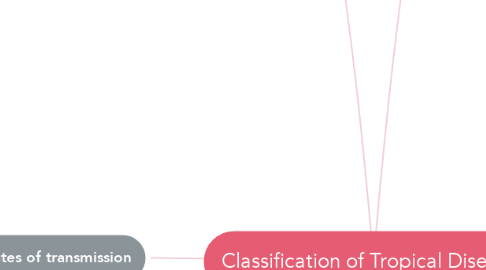
1. Main Organ System Involved
1.1. Gastrointestinal
1.1.1. Bacterial
1.1.1.1. Gastroenteritides, tuberculosis
1.1.2. Protozoal
1.1.2.1. Chagas Disease, amebiasis, giardia
1.1.3. Helminthic
1.1.3.1. Most of them
1.2. Hepatic
1.2.1. Bacterial
1.2.1.1. Leptospirosis
1.2.2. Protozoal
1.2.2.1. Amoebic, malaria, trypanosomiasis
1.2.3. Helminthic
1.2.3.1. Schistosomiasis, Liver trematodes
1.2.4. Viral
1.2.4.1. Hepatitis (A,B,C,D,E)/Yellow fewer, Herpes Viruses
1.3. Respiratory
1.3.1. Bacterial
1.3.1.1. Tuberculosis
1.3.2. Fungal
1.3.2.1. Blastomycosis
1.3.3. Helminthic
1.3.3.1. Paragonimiasis, strongyloides
1.3.4. Protozoal
1.3.4.1. Plasmodium falciparum
1.4. Cardiovascular
1.4.1. Bacterial
1.4.1.1. Endocarditis, rheumatic fever, tuberculosis, syphilis
1.4.2. Helminthic
1.4.2.1. Schistosomiasis
1.4.3. Protozoal
1.4.3.1. Chagas disease
1.5. Renal Tract
1.5.1. Bacterial
1.5.1.1. Poststreptococcal, Tuberculosis
1.5.2. Helminthic
1.5.2.1. Schistosomiasis
1.5.3. Protozoal
1.5.3.1. Plasmodium falciparum
1.5.4. Nuevo Tema
1.6. Nuevo Tema
1.7. Nuevo Tema
1.8. Musculoskeletal
1.8.1. Cystocercosis, tuberculosis
1.9. Dermatologic
1.9.1. Bacterial
1.9.1.1. Ulcers, syphilis,mycobacteria, anthrax
1.9.2. Fungal
1.9.2.1. Sporotrichosis, mycetoma, penicillium
1.9.3. Protozoal
1.9.3.1. Leishmaniasis
1.9.4. Helminthic
1.9.4.1. Acute schistosomiasis, onchocerciasis
1.9.5. Arthropods
1.9.5.1. Bites, stings, scabies, myiasis
1.10. Neurologic
1.10.1. Bacterial
1.10.1.1. Neisseria Meningitidis, botulism, diphtheria
1.10.2. Protozoal
1.10.2.1. Naegleria fowleri, Acanthamoebae, trypanosomiasis, plasmodium falciparum
1.10.3. Helminthic
1.10.3.1. Cysticercosis
1.10.4. Viral
1.10.4.1. HIV, HTLV-1, Japanese encephalitis, enteroviruses, rabies
2. Main routes of transmission
2.1. Mother to child
2.1.1. Congenital/vertical
2.1.1.1. Transplacental transmission via blood
2.1.2. Perinatal
2.1.2.1. Vaginal-cervical contact during delivery
2.1.2.2. Contact via breast milk
2.2. Airbone/inhalational
2.2.1. Inhalation of air, aerosol, finite contaminated by microbes
2.3. Contact of skin/ mucosa
2.3.1. Direct
2.3.1.1. Touching, kissing, sex
2.3.2. Indirect
2.3.2.1. Fomite, body fluid, secretions, stool, blood, plasma, pus
2.4. Ingestion
2.4.1. Ingestion of microorganisms, toxins or parasite ova/cysts by food or water
2.5. Direct penetration through skin
2.5.1. Helminth larvae
2.5.1.1. Swimmers itch, hookworm and roundworm larvae
2.5.2. Fly larve
2.5.2.1. Fly (bots and warbies) larvae (cutaneous mylases)
2.6. Animal and human bites
2.6.1. Viruses ( rabies, HIV,hepatitis B y C, Herpes spp
2.6.2. Bacterial infections, tetanus, actinomycosis
2.6.3. Rat bite fever, pasteurella, multocida, capnocytophaga
2.7. Innoculation or injection
2.7.1. Breach of skin or mucous membrane caused by needles
2.7.2. Tattoos, ear piercing, acupuncture, cupping
2.8. Arachnids
2.8.1. Mites
2.8.2. Ticks
2.9. Insect/arthropod-borne
2.9.1. Mosquitoes, sandfly and disease transmission
2.9.2. Tsetse flies, black flies, horse/deer flies
2.9.3. Lice, fleas
2.10. Multliple modes of transmission
2.10.1. Insect bites and airborne
2.10.2. Direct contact, airborne and ingestion of contaminated meat
2.10.3. Insect bites, blood transfusion, needles and congenital
2.10.4. Skin/mucosa contact, needles, blood transfusion
3. Neglected Tropical Diseases (NTDs)
3.1. Group of infections is strongly associated with poverty tropical and subtropical environments
3.1.1. Bacteria
3.1.1.1. Myn. Ulcernans, Mic. Leprae, Chlamydia Trachomatis, treponema perteneu
3.1.2. Viruses
3.1.2.1. Dengue, Zika, Chikunguña, Rabies
3.1.3. Fungi
3.1.3.1. Chromoblastomycosis and other deep mycosis
3.1.4. Protozoa
3.1.4.1. Plasmids spp, trypanosoma Cruzi, Leushmania spp, tryp. Gamblense
3.1.5. Helminths
3.1.5.1. Ascaris, Dracun medinensis, Onchocerca volvulus, Wuch Bacrofiti and Brugua Malayi, Amphimerus Fasciola Hepatic, clonorchis, echonococcus, schistosoma mansoni, taenia solium
3.1.6. Others
3.1.6.1. Snake Bite
